Related Research Articles

The American goldfinch is a small North American bird in the finch family. It is migratory, ranging from mid-Alberta to North Carolina during the breeding season, and from just south of the Canada–United States border to Mexico during the winter.
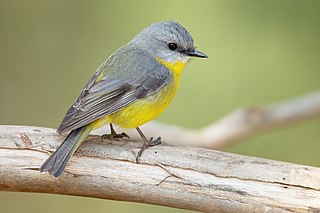
A songbird is a bird belonging to the suborder Passeri of the perching birds (Passeriformes). Another name that is sometimes seen as the scientific or vernacular name is Oscines, from Latin oscen, "songbird". The Passeriformes contains 5,000 or so species found all over the world, in which the vocal organ typically is developed in such a way as to produce a diverse and elaborate bird song.

Bird feeding is the activity of feeding wild birds, often by means of bird feeders. With a recorded history dating to the 6th century, the feeding of wild birds has been encouraged and celebrated in the United States and United Kingdom, with it being the United States' second most popular hobby having National Bird-Feeding Month congressionally decreed in 1994. Various types of food are provided by various methods; certain combinations of food and method of feeding are known to attract certain bird species.

The blue jay is a passerine bird in the family Corvidae, native to eastern North America. It lives in most of the eastern and central United States; some eastern populations may be migratory. Resident populations are also in Newfoundland, Canada; breeding populations are found across southern Canada. It breeds in both deciduous and coniferous forests, and is common in residential areas. Its coloration is predominantly blue, with a white chest and underparts, and a blue crest; it has a black, U-shaped collar around its neck and a black border behind the crest. Males and females are similar in size and plumage, and plumage does not vary throughout the year. Four subspecies have been recognized.

Steller's jay is a bird native to western North America and the mountains of Central America, closely related to the blue jay found in eastern North America. It is the only crested jay west of the Rocky Mountains. It is also sometimes colloquially called a "blue jay" in the Pacific Northwest, but is distinct from the blue jay of eastern North America. The species inhabits pine-oak and coniferous forests.
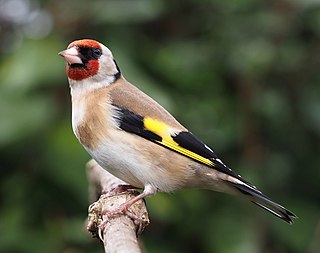
The European goldfinch or simply the goldfinch is a small passerine bird in the finch family that is native to Europe, North Africa and western and central Asia. It has been introduced to other areas, including Australia, New Zealand and Uruguay.
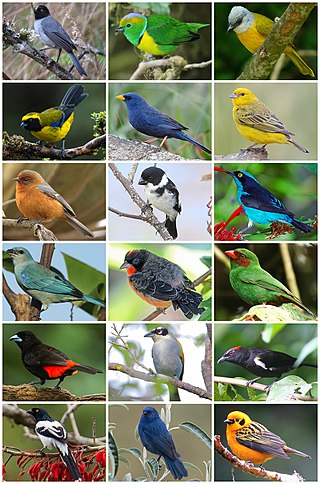
The tanagers comprise the bird family Thraupidae, in the order Passeriformes. The family has a Neotropical distribution and is the second-largest family of birds. It represents about 4% of all avian species and 12% of the Neotropical birds.

The Eurasian siskin is a small passerine bird in the finch family Fringillidae. It is also called the European siskin, common siskin or just siskin. Other (archaic) names include black-headed goldfinch, barley bird and aberdevine. It is very common throughout Europe and Eurosiberia. It is found in forested areas, both coniferous and mixed woodland where it feeds on seeds of all kinds, especially of alder and conifers.

The house finch is a bird in the finch family Fringillidae. It is native to western North America and has been introduced to the eastern half of the continent and Hawaii. This species and the other two American rosefinches are placed in the genus Haemorhous.
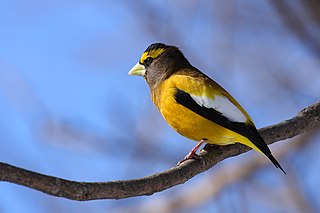
The evening grosbeak is a passerine bird in the finch family Fringillidae found in North America.

The pine siskin is a North American bird in the finch family. It is a migratory bird with an extremely sporadic winter range.

A birdfeeder, bird table, or tray feeder is a device placed outdoors to supply bird food to birds. The success of a bird feeder in attracting birds depends upon its placement and the kinds of foods offered, as different species have different preferences.

A companion parrot is a parrot kept as a pet that interacts abundantly with its human counterpart. Generally, most species of parrot can make excellent companions, but must be carefully managed around other common pet species like dogs and cats as they might be hostile towards them.

Millikin University is a private college in Decatur, Illinois. It was founded in 1901 by prominent Decatur businessman James Millikin and is affiliated with the Presbyterian Church (USA).

Guizotia abyssinica is an erect, stout, branched annual herb, grown for its edible oil and seed. Its cultivation originated in the Eritrean and Ethiopian highlands, and has spread to other parts of Ethiopia. Common names include noog/nug ; niger, nyger, or nyjer seed ; ramtil or ramtilla; inga seed; and blackseed.

The chestnut-backed chickadee, formerly Parus rufescens, is a small passerine bird in the tit family, Paridae.

Bird food or bird seed is food intended for consumption by wild and domestic birds. While most bird food is fed to commercial fowl, bird food is also used to feed pet birds or to provide a feeding site for wild birds.
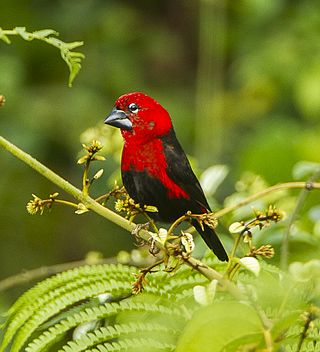
The black-bellied seedcracker is a bird species of the family Estrildidae. They live in most Central African countries and inhabit tropical rainforest. The species comprises individuals with different physical appearance which are grouped into three categories. Adults are mainly granivorous but diet preference varies with bill size and food availability. Black-bellied seedcrackers also exhibit very distinctive colorations with bright patches of black and red, making them easy to identify in the field. Overall, little is known about this species apart from its range, but intensive studies are currently looking at bill size variations among individuals and their effects on behaviors.

The medium ground finch is a species of bird in the family Thraupidae. It is endemic to the Galapagos Islands. Its primary natural habitat is tropical shrubland. One of Darwin's finches, the species was the first which scientists have observed evolving in real-time.

February is National Bird-Feeding Month in the United States. This celebratory month was created to educate the public on the wild bird feeding and watching hobby. Because of National Bird-Feeding Month, February has become the month most recognized with wild bird feeding promotions and activities.
References
- ↑ About the NBFS
- 1 2 3 Baicich, Paul J., Margaret A. Barker and Carrol L. Henderson. Feeding Wild Birds: A Short History in America (USA: Wild Bird Centers of America, Inc., 2010) ISBN 1-4515-1005-5
- 1 2 3 Lukas, David. "For the Birds: Which Seeds are Best?" National Wildlife Magazine Oct./Nov. 2009: 14–15. Print.
- 1 2 3 Freeman, Huey. "Every Move They Make." Herald & Review [Decatur, IL] 10 November 2009. Print.
- 1 2 3 4 5 6 Richardson, Scott. "Feeding Time." Pantagraph [Bloomington, IL] 31 January 2010. Print.
- 1 2 3 4 5 Baicich, Paul J. "Revitalizing the NBFS." Bird Watcher's Digest Nov./Dec. 2009: 11. Print.
- ↑ "Millikin Becomes New Home of National Bird-Feeding Society." The Southern [Carbondale, IL] 31 January 2010. Print.
- ↑ Busch, Simon. "An Avian Appetite." Financial Times [United Kingdom] 20 January 2008. Web.
- ↑ Reichenberger, Larry. "Bird Feeding Faceoff." The Homestead 2008: 22–23. Print.
- ↑ Bird, David M. "Help Determine the Future Menus for Feeder Birds." Bird Watcher's Digest Mar./Apr. 2008: 8. Print.
- 1 2 "PROJECT WILDBIRD Results".
- 1 2 Freeman, Huey. "Turns Out, Birds Really are Picky Eaters." Herald & Review [Decatur, IL] 10 November 2009. Print.
- 1 2 Bird Feeders
- ↑ NBFS Wild Bird Feeder Preference Chart
- ↑ Other Bird Feeders